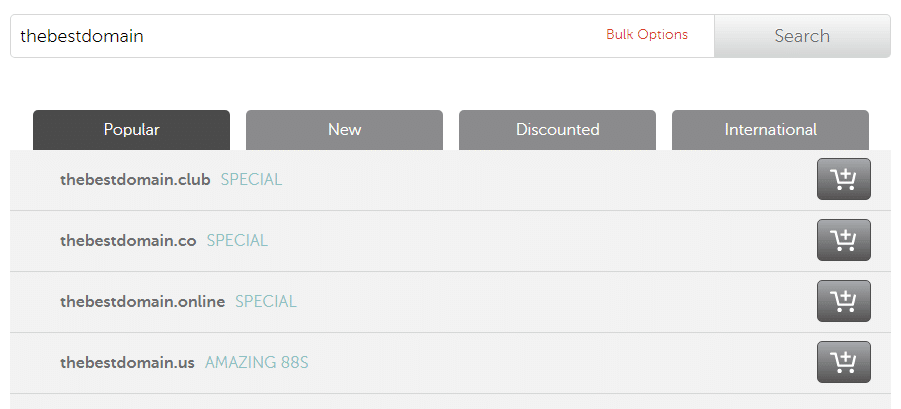Has the time come to choose your tour and activities company’s first custom domain? Are the options overwhelming, or is everything you try already taken? Don’t worry — these seven steps will make it easy.
1. Make it memorable
The best domains are short, concise, and memorable. While the Amazons and Googles of the web have all been snatched up long-since, there are still plenty of options available.
The first choice for most companies is their company name, or some portion of it. If you’re just starting out, it’s worth considering whether a strong, memorable domain is available for any company name you consider. If you’re already established and your company’s name is already in use by someone else, consider an a alternative version — just be certain that it’s still pronounceable. No one’s going to find you at AwsmTrs.com if your company name is Awesome Tours.
If there’s nothing close to be had, it’s time to get creative.
2. Choose keywords with care
Your tour and activities company isn’t a tech startup, so you probably don’t want to bother with highly-brandable nonsense like Flickr or Lyft. A descriptive domain name is a better idea, but you have to take care with keywords.
For a company that sells experiences, ideal keywords might be as simple as what you offer and where you’re located. Just don’t be too literal. CitynameFoodTours.com might seem like the obvious answer for a food tour company, but search engine experts note that domains that exactly match generic search terms have started to be downranked by Google. Those domains are known as Exact-Match Domains (EDMs) in the SEO business, and they’re not currently recommended.
A keyword or two can be safe, but it’s best if you can accompany them with something unique and brandable. Get creative with prefixes and suffixes.
On the other hand, don’t even consider stuffing as many keywords as you can into a single domain. NewYorkManhattanBroadwayWalkingToursForLess might get a lot of information across, but Google will definitely identify it as spam.
3. Be concise, and avoid waste.
Shorter is better, and articles like “an” and “the” take up space that isn’t going to good use. Not only are you creating a domain that will be harder for users to remember, you’re also creating the opportunity for a lot of confusion. If your domain is TheVeryBestExampleTours, you’re inviting your competition to steal your traffic by grabbing VeryBestExampleTours.com, or BestExampleTours.com.
If your domain name is already in use, it can be tempting to sneak around the problem by registering a hyphenated version, like Very-Best-Example-Tours.com. It’s a reasonable approach, but it comes with a few issues:
- Search engines may associate hyphenated domains with spammers and fraudsters.
- Hyphenated domains are longer than they need to be.
- Customers will confuse the hyphenated and non-hyphenated versions of the domain.
Better to find a shorter, unique domain that doesn’t leave room for confusion. Even if you have to diverge from your ideal domain name a bit.
While you’re watching out for wasted characters, keep an eye out for confusing combos, too. Double letters are especially tricky, like in besttourssouthwest.com. Commonly misspelled words should also be avoided where possible.
4. Start searching.
Once you have a few good ideas, head on over to a domain name registrar to search for available domains. It may turn out that none of your ideal domains are available, but good registrars offer similar results that you might be able to use. If there’s nothing good there, it’s time to start practicing a bit of free association.
Take your ideal domain apart and consider what other words could get the same idea across. Try being more specific about what you offer, or find a broader alternative. Pull out your thesaurus and find alternatives that people might actually use. ExampleWalkingTours won’t be recognizable if you change it to SampleAmbulatoryPeregrination, but ExampleWalkingExpeditions might work.
5. Corner that .com.
In the past few years, the domain authorities have made many new top level domains (TLDs) available. Rather than being limited to .com, .net, .org and country code TLDs like .ca, there’s a whole range of new options, like .travel, .me, or .online.
Even with such a rich selection, .com is still the TLD of choice. It’s the most memorable, the first to come to mind when customers are trying to recall your domain. If the .com of the domain you want is already taken, its owner is going to have a huge advantage over you with your identical .xyz.
That said, .travel and its ilk can be bold choices, which might suit your company. Get the .com if you can, but if you want to be creative, the options are a lot wider than they were just a few years ago.
6. Show it off
Picked the perfect domain name? Ensured it’s available? Before you start printing your new brochures, show it around to a few people you trust.
Here are a few questions your confidantes can help you answer:
- Does it suit my business?
- Is it easy to understand?
- Is it memorable?
- Could it be confused for something else?
That last point is important. When you already know what your domain is supposed to convey, you might not notice the ways it could be misinterpreted. For example, ChooseSpain.com often gets called out as an easily-confused domain name. Why? Because it could just as easily be read as ChoosesPain.com. A second pair of eyes can help you avoid a potentially embarrassing mix up.
7. Secure the competition
Once you have your ideal domain name, look around for similar domains that could be used to mislead customers or could direct them away from your website. Buying the same domain with other common TLDs can be a good idea – you don’t want a fraudster using ExampleTourCompany.ca to direct customers away from your business at ExampleTourCompany.com. Common misspellings are also worth securing.
You can direct multiple domains to the same place using redirects without taking a hit to your search engine rankings, or you can keep them unused — once you register them, they’re yours to do with as you will.
Emoji domains?
Communicating in emoji is nothing new — popular as they are today, emoji have been in use since 1999. They communicate a lot in a very small space, they cross language barriers, and they’re well-established. Those all seem like valuable assets in a domain name, so are emoji domains a good idea?
First things first: yes, emoji domains exist. They’ve recently gained a bit of popularity, too, thanks to the arrival of easy-to-use emoji domain registrars. That doesn’t necessarily mean you should get one, though. They have a few strikes against them.
- Non-mobile users rarely know how to access them.
- Not all browsers render them correctly.
- Most common TLDs don’t support emoji.
That said, if your brand is already tied closely with a specific group of emoji, it certainly couldn’t hurt to register an emoji domain as a secondary domain. If emoji domains don’t get popular, you’ll still have a novel domain that might help you stand out. If emoji domains do get more mainstream, you’ll be ahead of the crowd.
For most of us, emoji domains aren’t accessible enough — and they’re definitely not ready to be used as primary domains. If nothing about your brand screams for emojis, there’s really no reason to worry about emoji domains just yet.








